Module 8 Choosing presents Unit 3 Language in use 一般现在时语法课件(66张PPT)
文档属性
| 名称 | Module 8 Choosing presents Unit 3 Language in use 一般现在时语法课件(66张PPT) |  | |
| 格式 | zip | ||
| 文件大小 | 2.3MB | ||
| 资源类型 | 教案 | ||
| 版本资源 | 外研版 | ||
| 科目 | 英语 | ||
| 更新时间 | 2018-09-17 08:38:34 | ||
图片预览

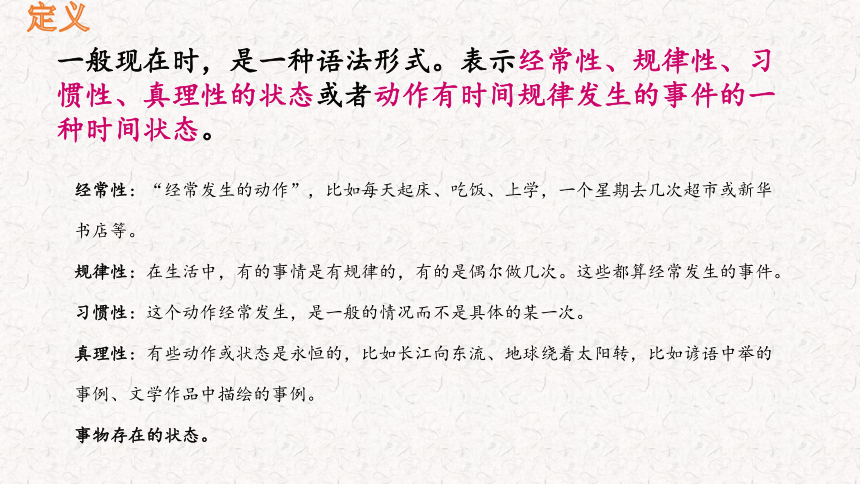
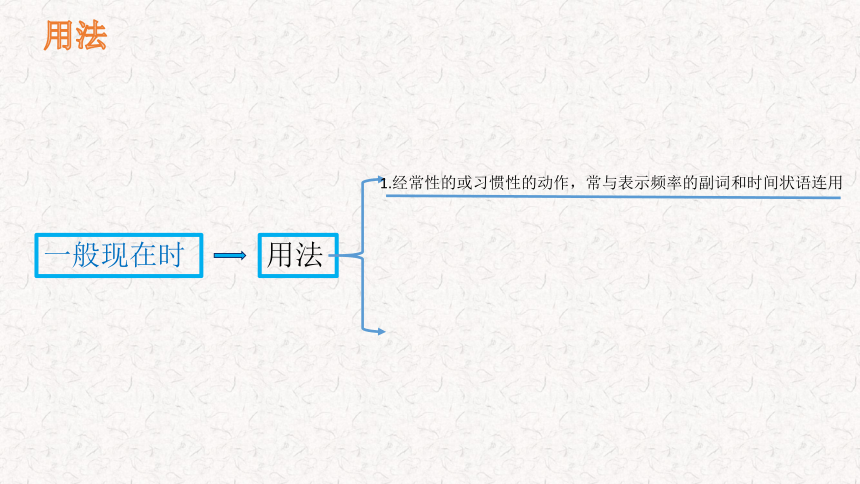
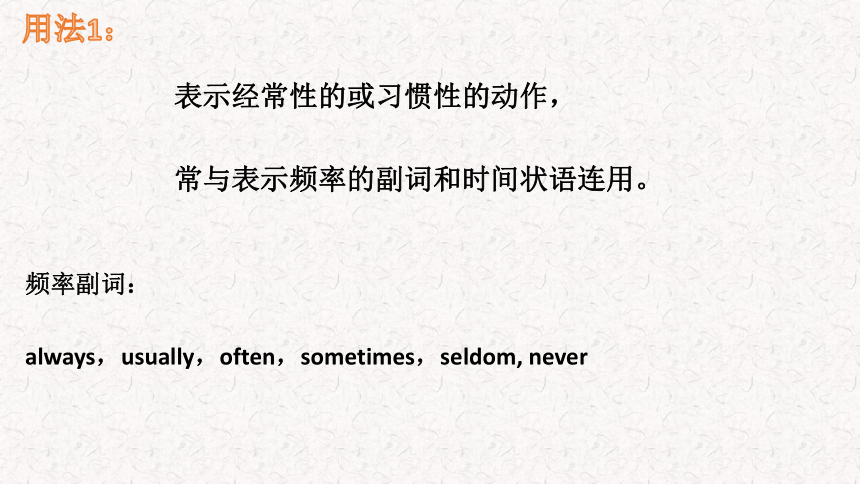
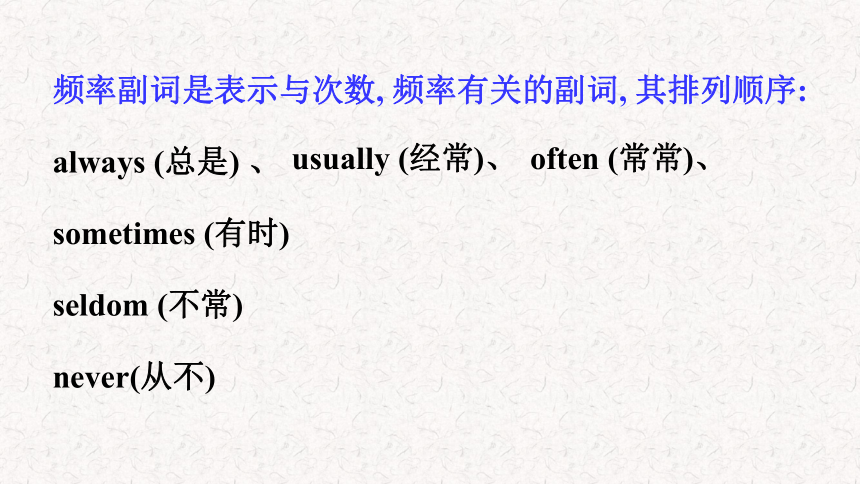
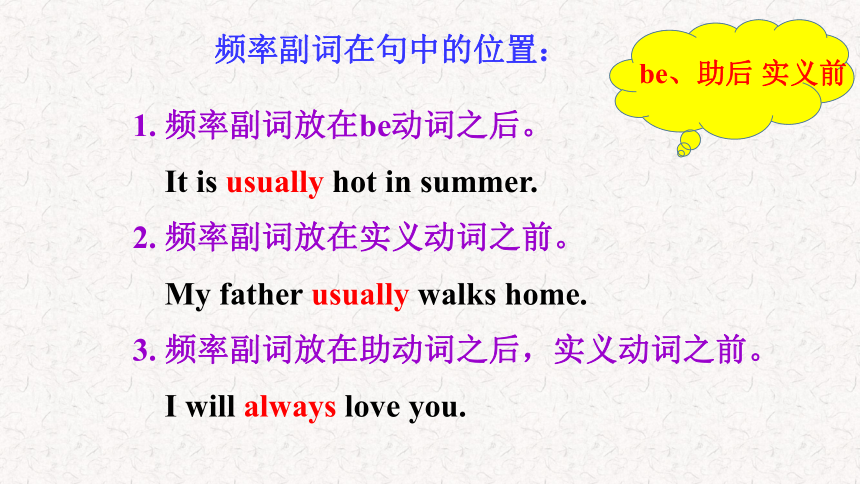
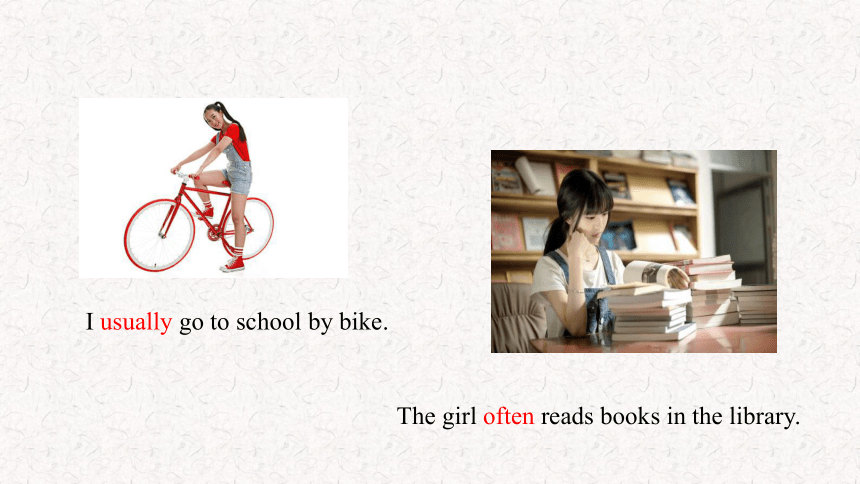
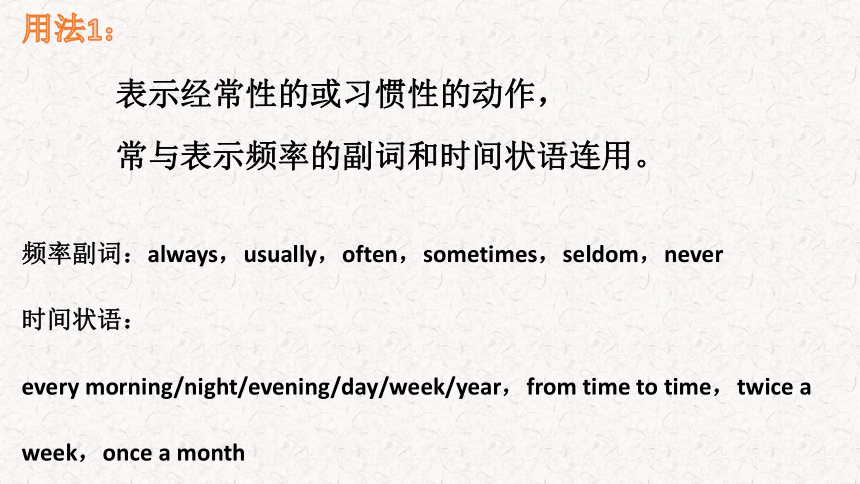
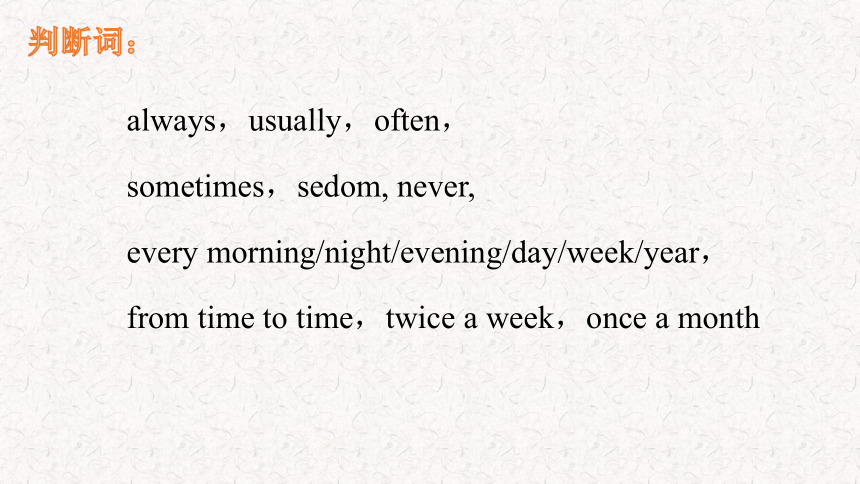
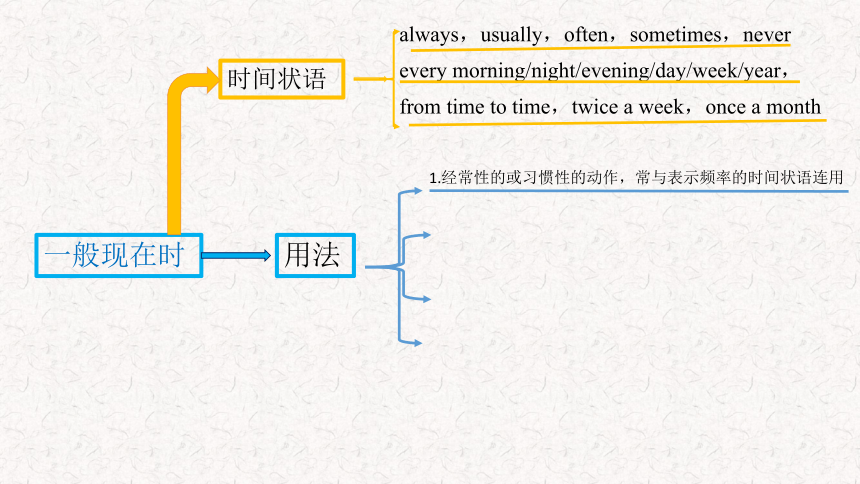
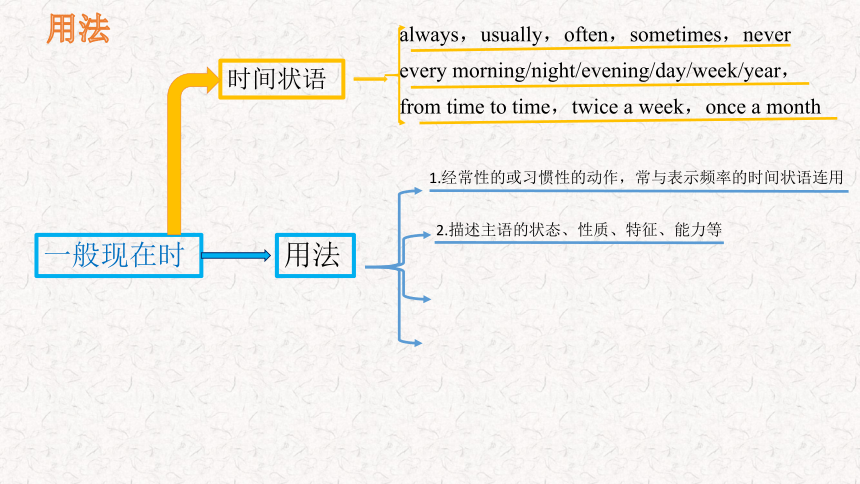

文档简介
一般现在时
Grammar
The Simple Present Tense
一般现在时,是一种语法形式。表示经常性、规律性、习惯性、真理性的状态或者动作有时间规律发生的事件的一种时间状态。
经常性:“经常发生的动作”,比如每天起床、吃饭、上学,一个星期去几次超市或新华书店等。
规律性:在生活中,有的事情是有规律的,有的是偶尔做几次。这些都算经常发生的事件。
习惯性:这个动作经常发生,是一般的情况而不是具体的某一次。
真理性:有些动作或状态是永恒的,比如长江向东流、地球绕着太阳转,比如谚语中举的事例、文学作品中描绘的事例。
事物存在的状态。
定义
一般现在时
用法
1.经常性的或习惯性的动作,常与表示频率的副词和时间状语连用
用法
频率副词:
always,usually,often,sometimes,seldom, never
用法1:
表示经常性的或习惯性的动作,
常与表示频率的副词和时间状语连用。
频率副词是表示与次数, 频率有关的副词, 其排列顺序:
always (总是) 、
sometimes (有时)
seldom (不常)
never(从不)
often (常常)、
usually (经常)、
1. 频率副词放在be动词之后。
It is usually hot in summer.
2. 频率副词放在实义动词之前。
My father usually walks home.
3. 频率副词放在助动词之后,实义动词之前。
I will always love you.
频率副词在句中的位置:
be、助后 实义前
I usually go to school by bike.
The girl often reads books in the library.
频率副词:always,usually,often,sometimes,seldom,never
时间状语:
every morning/night/evening/day/week/year,from time to time,twice a week,once a month
用法1:
表示经常性的或习惯性的动作,
常与表示频率的副词和时间状语连用。
判断词:
always,usually,often,
sometimes,sedom, never,
every morning/night/evening/day/week/year,
from time to time,twice a week,once a month
一般现在时
用法
1.经常性的或习惯性的动作,常与表示频率的时间状语连用
时间状语
always,usually,often,sometimes,never
every morning/night/evening/day/week/year,from time to time,twice a week,once a month
一般现在时
用法
1.经常性的或习惯性的动作,常与表示频率的时间状语连用
时间状语
always,usually,often,sometimes,never
every morning/night/evening/day/week/year,from time to time,twice a week,once a month
2.描述主语的状态、性质、特征、能力等
用法
目的是为了“描述现阶段的动作或者状态”
用法2:
描述主语的状态、性质、特征、能力等
The girl can play basketball.
The woman is a teacher.
The boy and the girl are students.
一般现在时
用法
1.经常性的或习惯性的动作,常与表示频率的时间状语连用
时间状语
always,usually,often,sometimes,never
every morning/night/evening/day/week/year,from time to time,twice a week,once a month
2.描述主语的状态、性质、特征、能力等
用法
3.陈述客观真理,客观存在,科学事实
陈述客观真理、客观存在、科学事实
moves
The earth ______(move) around the sun.
用法3:
一般现在时
用法
1.经常性的或习惯性的动作,常与表示频率的时间状语连用
时间状语
always,usually,often,sometimes,never
every morning/night/evening/day/week/year,from time to time,twice a week,once a month
2.描述主语的状态、性质、特征、能力等
用法
3.陈述客观真理,客观存在,科学事实
4.在格言或警句中
Pride goes before a fall. 骄者必败。
在格言或警句中
用法4:
Practice makes perfect. 熟能生巧。
一般现在时
用法
1.经常性的或习惯性的动作,常与表示频率的时间状语连用
时间状语
always,usually,often,sometimes,never
every morning/night/evening/day/week/year,from time to time,twice a week,once a month
2.描述主语的状态、性质、特征、能力等
3.陈述客观真理,客观存在,科学事实
4.在格言或警句中
构成
be动词用am, is , are
一般现在时
用法
1.经常性的或习惯性的动作,常与表示频率的时间状语连用
时间状语
always,usually,often,sometimes,never
every morning/night/evening/day/week/year,from time to time,twice a week,once a month
2.描述主语的状态、性质、特征、能力等
3.陈述客观真理,客观存在,科学事实
4.在格言或警句中
构成
be动词用am, is , are
实义动词通常用动词原形表示,主语为第三人称单数时,动词要用第三人称单数形式
构成
be 动词的一般现在时
实义(行为)动词的一般现在时
be 动词的一般现在时
Part Ⅰ
I a teacher.
am
He a boy.
is
They students.
are
我I用am,你you用are,
is连着他(he),她(she),它(it);
单数名词用is, 复数名词全用are。
be变形记
用be动词的适当形式填空
Amy ____ her sister.
2. His name _____ Kate.
3. --What ____ your phone number?
--It _____284-2942.
4. Her brother’s name _____ John.
5. I a teacher. You a student. You and I family.
is
is
is
is
is
Practice and Test
课堂检测
am
are
are
I am a student.
He is twelve.
They are in the classroom.
肯定句结构:主语+be动词+其他
句型结构
is not=isn’t
are not=aren't
否定句结构:主语+be动词+not+其他
1. I am a student.(改为否定句)
2. He is twelve.(改为否定句)
3. They are in the classroom. (改为否定句)
I am not a student.
He is not twelve.
They are not in the classroom.
句型结构
肯定回答:Yes, 主语+be.
否定回答:No, 主语+be not.
一般疑问句: Be动词+主语+其他?
1. I am a student.(改为一般疑问句)
2. He is twelve.(改为一般疑问句)
3. They are in the classroom. (改为一般疑问句)
Are you a student?
Is he twelve?
Are they in the classroom?
句型结构
1. I am a student.(划线提问)
2. He is twelve.(划线提问)
3. They are in the classroom. (划线提问)
特殊疑问句:特殊疑问词+be动词+主语+其他?
What are you?
How old is he?
Where are they?
句型结构
我I用am,你you用are,
is连着他(he),她(she),它(it);
单数名词用is, 复数名词全用are;
变疑问,往前提,句末问号莫丢弃。
变否定,更容易,be后not莫忘记。
疑问否定任你变,句首大写莫迟疑。
总结:
? 用be的适当形式填空??
1.I___?David,and?my?family?name___?Green.?
2.Look!These____apple?trees.?
3.We____?good?students?and?you____?a good?teacher.?
4.My?sister?and?my?brother_____?students.?
5._____there?many?eggs?in?the?kitchen??
6.____your?card?number?5578?
7.Where_____?your?pencils??
8.How?much?____?his?jacket??
9、There_____a?boy?and?two?girls?at?the?gate.?
10、Five?and?three?____?eight.
is
am
are
are
are
are
Are
Is
are
is
is
is
课堂检测 1
1.?Those?are?his?books.(改为否定句)
2.?These?things?are?five?dollars.(改为一般疑问句)
3.?Our?teachers?are?in?the?classroom.?(划线提问)
??
4.?Her?pen?is?black.(划线提问)
5.?The?boy?is?fine.?(划线提问)
课堂检测 2
句型转换
Those aren't his books.
Are these things five dollars?
Who are in the classroom?
What colour is her pen?
How is the boy?
含有be动词的一般现在时
句型结构:
肯定句结构:主语 + be + 表语
否定句结构:主语 + be + not + 表语
一般疑问句结构:Be + 主语 + 表语?
特殊疑问句结构:特殊疑问词 + be + 主语+表语?
小结
实义(行为)动词的
一般现在时
Part Ⅱ
说说看看
I like playing basketball.
The girl often apples.
The two boys usually apples.
eats
eat
说说看看
That boy always TV.
Tim and his mother sometimes TV.
watches
watch
说说看看
The girl often eats apples.
These two boys usually eat apples.
That boy always watches TV.
Tim and his mother sometimes watch TV.
动词三单形式
eats, watches
现在经常性的动作或状态
1.主语是 和 时(主语非三单) ,
动词不用做任何变化,即动词用原形表示。
名词复数
第一人称
We usually go to school at 7:30.
我们通常7:30上学去。
My parents give ten yuan to my sister every week.
我父母每星期给我妹妹十元钱。
肯定句结构:主语+动词原形+其他
句型结构
1. My parents give ten yuan to my sister every week. (改为否定句)
My parents don’t give ten yuan to my sister every week.
2. We go to school by bus.(改为否定句)
We don’t go to school by bus.
否定句: 主语+don't+动词原形+其他
句型结构
1. My parents give ten yuan to my sister every week.
(改为一般疑问句并作肯定回答)
Do your parents give ten yuan to your sister every week?
Yes, they do.
2. We usually go to school at 7:30.
(改为一般疑问句并作否定回答)
Do you usually go to school at 7:30?
No, they don’t.
肯定:Yes, 主语+do.
否定:No,主语+don’t.
一般疑问句: Do+主语+动词原形+其他
句型结构
特殊疑问句: 特殊疑问词+do+主语+动词原形+其他
句型结构
1. My parents give ten yuan to my sister every week.
(划线提问)
2. We usually go to school at 7:30.(划线提问)
How often do your parents give ten yuan to your sister?
When do you usually go to school?
How often “多久(一次)”
是对表示频度副词的时间状语的提问
2.主语是 时,谓语动词要进行必要的变化。
什么是第三人称单数呢?
第三人称单数
1.人称代词he, she, it是第三人称单数
1).He likes watching TV.
他喜欢看电视.
2).She has lunch at twelve.
他十二点吃午餐.
3). It looks like a cat.
它看起来象只猫.
2. 单个人名、地名或称呼作主语时,是第三人称单数.
1).Han Mei watches TV with her mother.
韩梅和她的母亲看电视.
2).Beijing is the capital of China.
北京是中国的首都.
He often gets up at 6:00 in the morning.
1.人称代词he, she, it作主语时,动词用第三人称单数形式。
Peter listens to the radio at 7.a.m.
2.单个人名、地名或称呼作主语时,动词用第三人称单数形式。
This/That book is yours.
A horse is a useful animal.
3. 单数可数名词或“this/that/the/a + 可数名词单数”作主语时,动词用第三人称单数形式。
Everyone is here./This is a pen.
4. 不定代词someone, somebody, nobody等及指示代词this,that作主语时,动词用第三人称单数形式。
The milk is in the glass.
5.不可数名词作主语时,动词用第三人称单数形式。
“19” is a lucky number./ “I” is a letter.
6.当数字或字母作主语时,看作第三人称单数,动词用第三人称单数形式。
Think it over
主语是第三人称单数时,
实义动词要用 。
动词的第三人称单数形式
动词的第三人称单数形式
变化规则
一般情况下,直接加s
work---
rain---
see---
works
sees
rains
2. 以 sh,ch,s,x或o结尾的词后加-es
wash---
teach---
fix---
do---
go---
washes
teaches
fixes
does
goes
3.以辅音字母加y结尾的, 先把y变成i,再加es。
study---
fly---
carry---
元音字母+y结尾直接加s。plays
studies
flies
carries
写出下列动词的第三人称单数形式
work
study
drive
wash
watch
fly
spell
speak
say
like
do
have
works
studies
drives
washes
watches
flies
spells
speaks
says
likes
does
has
Practise
课堂检测
Jim likes playing basketball.
Mary studies English and Chinese at school.
肯定句:主语(He/She/It)+动词三单形式+其他
句型结构
1. Jim likes playing football.(改为否定句)
Jim doesn’t like playing football.
否定句:主语+doesn't+动词原形+其他。
2. Mary studies Chinese at school.(改为否定句)
Mary doesn't study Chinese at school.
句型结构
1. Kate likes singing every morning.(改为一般疑问句)
2. Lily often writes to her uncle in Canada.(改为一般疑问句)
Does Kate like singing every morning?
Does Lily often write to her uncle in Canada?
一般疑问句:Does+主语+动词原形+其他?
肯定回答: Yes,主语+does.
否定回答: No,主+doesn't.
句型结构
1. Jim eats some bread every morning.(划线提问)
2. Kate comes from America.(划线提问)
What does Jim eat every morning?
Where does Kate come from?
特殊疑问句:特殊 疑问词+does+主语+动词原形+其他?
句型结构
含有实义动词的一般现在时
主语非三单:
肯定句结构:主语+动词原形+其他.
一般疑问句结构:Do +主语+动词原形+其他?
否定句结构:主语+don't +动词原形+其他.
特殊疑问句结构:特殊疑问词+do +主语+动词原形+其他?
主语是三单:
肯定句结构:主语+动词三单+其他.
否定句结构:主语+doesn't +动词原形+其他.
一般疑问句结构:Does +主语+动词原形+其他?
特殊疑问句结构:特殊疑问词+does +主语+动词原形+其他?
一般现在时综合练习
Practice makes perfect!
孰能生巧
写出下列单词的第三人称单数形式
live------ _________ discuss--- _______
have--- ________ hurry--- ________
go---- ________ wash--- ________
stay-------- _________ be---________
enjoy------ _________ collect---- _______
lives
has
goes
stays
enjoys
discusses
hurries
washes
is
collects
课堂检测 1
1._____ you have a book ?????
A Do???B. Are????????C. Is??????D. Have
2.Does Li Lei like to watch TV? ______________.
A. Yes, he like.?????? B. No, he doesn’t??.
C. Yes, he’d like.????????D. No, he likes.
3.She doesn’t ______ her homework in the afternoon.??
A. doing???B. to do???C. does??????D. do
4.How ____ Mr. Smith ______ to England????
A. do, go?? B. is , go??
C. does, go?? D. does , goes
选择最佳答案
课堂检测 2
5. _____ she ______ home at six every day?
A. Is , leave?? B. Does , leave
C. Is , leaves?? D. Does , left
6. I want____homework now.
A .doing????B. to do???C.to do my????D.do my
7. It's time______.
??A.go to school????B.play games??
C.to go home?????D.to do my homeworks
8.-____you ____the blackboard???
-Yes,I can.
??A.Can, clean????? B.Am, cleaning??
C.Are, cleaning????D.Do, clean
?用括号内动词的适当形式填空。???????????
1.?We?often___________(play)?in?the?playgound.?
2.?He??usually?_________(get)?up?at?six?o’clock.?
3.__________you_________(brush)?your?teeth??every?morning??
4.?What???? ? he?usually?? ?(do)?after?school??
5.?Danny? (study)?English,Chinese,Maths,Science?and?Art?an?school.?
6.?Mike?sometimes?__________(go)?to?the?park??with?his?sister.?
7.?On Monday evenings,?she?_______ ___(not watch)?TV?with?his?parents.
?8.?________?Mike________(read)?English?every??day??
9.How??many??lessons_______you________(have)?on?Monday??
10.?What?time_________his?mother_________(do)?the??housework?
课堂检测 3
play
gets
Do
brush
does
do
studies
goes
doesn't watch
Does
read
do
have
does
do
时间状语
summary
Thank you!
Grammar
The Simple Present Tense
一般现在时,是一种语法形式。表示经常性、规律性、习惯性、真理性的状态或者动作有时间规律发生的事件的一种时间状态。
经常性:“经常发生的动作”,比如每天起床、吃饭、上学,一个星期去几次超市或新华书店等。
规律性:在生活中,有的事情是有规律的,有的是偶尔做几次。这些都算经常发生的事件。
习惯性:这个动作经常发生,是一般的情况而不是具体的某一次。
真理性:有些动作或状态是永恒的,比如长江向东流、地球绕着太阳转,比如谚语中举的事例、文学作品中描绘的事例。
事物存在的状态。
定义
一般现在时
用法
1.经常性的或习惯性的动作,常与表示频率的副词和时间状语连用
用法
频率副词:
always,usually,often,sometimes,seldom, never
用法1:
表示经常性的或习惯性的动作,
常与表示频率的副词和时间状语连用。
频率副词是表示与次数, 频率有关的副词, 其排列顺序:
always (总是) 、
sometimes (有时)
seldom (不常)
never(从不)
often (常常)、
usually (经常)、
1. 频率副词放在be动词之后。
It is usually hot in summer.
2. 频率副词放在实义动词之前。
My father usually walks home.
3. 频率副词放在助动词之后,实义动词之前。
I will always love you.
频率副词在句中的位置:
be、助后 实义前
I usually go to school by bike.
The girl often reads books in the library.
频率副词:always,usually,often,sometimes,seldom,never
时间状语:
every morning/night/evening/day/week/year,from time to time,twice a week,once a month
用法1:
表示经常性的或习惯性的动作,
常与表示频率的副词和时间状语连用。
判断词:
always,usually,often,
sometimes,sedom, never,
every morning/night/evening/day/week/year,
from time to time,twice a week,once a month
一般现在时
用法
1.经常性的或习惯性的动作,常与表示频率的时间状语连用
时间状语
always,usually,often,sometimes,never
every morning/night/evening/day/week/year,from time to time,twice a week,once a month
一般现在时
用法
1.经常性的或习惯性的动作,常与表示频率的时间状语连用
时间状语
always,usually,often,sometimes,never
every morning/night/evening/day/week/year,from time to time,twice a week,once a month
2.描述主语的状态、性质、特征、能力等
用法
目的是为了“描述现阶段的动作或者状态”
用法2:
描述主语的状态、性质、特征、能力等
The girl can play basketball.
The woman is a teacher.
The boy and the girl are students.
一般现在时
用法
1.经常性的或习惯性的动作,常与表示频率的时间状语连用
时间状语
always,usually,often,sometimes,never
every morning/night/evening/day/week/year,from time to time,twice a week,once a month
2.描述主语的状态、性质、特征、能力等
用法
3.陈述客观真理,客观存在,科学事实
陈述客观真理、客观存在、科学事实
moves
The earth ______(move) around the sun.
用法3:
一般现在时
用法
1.经常性的或习惯性的动作,常与表示频率的时间状语连用
时间状语
always,usually,often,sometimes,never
every morning/night/evening/day/week/year,from time to time,twice a week,once a month
2.描述主语的状态、性质、特征、能力等
用法
3.陈述客观真理,客观存在,科学事实
4.在格言或警句中
Pride goes before a fall. 骄者必败。
在格言或警句中
用法4:
Practice makes perfect. 熟能生巧。
一般现在时
用法
1.经常性的或习惯性的动作,常与表示频率的时间状语连用
时间状语
always,usually,often,sometimes,never
every morning/night/evening/day/week/year,from time to time,twice a week,once a month
2.描述主语的状态、性质、特征、能力等
3.陈述客观真理,客观存在,科学事实
4.在格言或警句中
构成
be动词用am, is , are
一般现在时
用法
1.经常性的或习惯性的动作,常与表示频率的时间状语连用
时间状语
always,usually,often,sometimes,never
every morning/night/evening/day/week/year,from time to time,twice a week,once a month
2.描述主语的状态、性质、特征、能力等
3.陈述客观真理,客观存在,科学事实
4.在格言或警句中
构成
be动词用am, is , are
实义动词通常用动词原形表示,主语为第三人称单数时,动词要用第三人称单数形式
构成
be 动词的一般现在时
实义(行为)动词的一般现在时
be 动词的一般现在时
Part Ⅰ
I a teacher.
am
He a boy.
is
They students.
are
我I用am,你you用are,
is连着他(he),她(she),它(it);
单数名词用is, 复数名词全用are。
be变形记
用be动词的适当形式填空
Amy ____ her sister.
2. His name _____ Kate.
3. --What ____ your phone number?
--It _____284-2942.
4. Her brother’s name _____ John.
5. I a teacher. You a student. You and I family.
is
is
is
is
is
Practice and Test
课堂检测
am
are
are
I am a student.
He is twelve.
They are in the classroom.
肯定句结构:主语+be动词+其他
句型结构
is not=isn’t
are not=aren't
否定句结构:主语+be动词+not+其他
1. I am a student.(改为否定句)
2. He is twelve.(改为否定句)
3. They are in the classroom. (改为否定句)
I am not a student.
He is not twelve.
They are not in the classroom.
句型结构
肯定回答:Yes, 主语+be.
否定回答:No, 主语+be not.
一般疑问句: Be动词+主语+其他?
1. I am a student.(改为一般疑问句)
2. He is twelve.(改为一般疑问句)
3. They are in the classroom. (改为一般疑问句)
Are you a student?
Is he twelve?
Are they in the classroom?
句型结构
1. I am a student.(划线提问)
2. He is twelve.(划线提问)
3. They are in the classroom. (划线提问)
特殊疑问句:特殊疑问词+be动词+主语+其他?
What are you?
How old is he?
Where are they?
句型结构
我I用am,你you用are,
is连着他(he),她(she),它(it);
单数名词用is, 复数名词全用are;
变疑问,往前提,句末问号莫丢弃。
变否定,更容易,be后not莫忘记。
疑问否定任你变,句首大写莫迟疑。
总结:
? 用be的适当形式填空??
1.I___?David,and?my?family?name___?Green.?
2.Look!These____apple?trees.?
3.We____?good?students?and?you____?a good?teacher.?
4.My?sister?and?my?brother_____?students.?
5._____there?many?eggs?in?the?kitchen??
6.____your?card?number?5578?
7.Where_____?your?pencils??
8.How?much?____?his?jacket??
9、There_____a?boy?and?two?girls?at?the?gate.?
10、Five?and?three?____?eight.
is
am
are
are
are
are
Are
Is
are
is
is
is
课堂检测 1
1.?Those?are?his?books.(改为否定句)
2.?These?things?are?five?dollars.(改为一般疑问句)
3.?Our?teachers?are?in?the?classroom.?(划线提问)
??
4.?Her?pen?is?black.(划线提问)
5.?The?boy?is?fine.?(划线提问)
课堂检测 2
句型转换
Those aren't his books.
Are these things five dollars?
Who are in the classroom?
What colour is her pen?
How is the boy?
含有be动词的一般现在时
句型结构:
肯定句结构:主语 + be + 表语
否定句结构:主语 + be + not + 表语
一般疑问句结构:Be + 主语 + 表语?
特殊疑问句结构:特殊疑问词 + be + 主语+表语?
小结
实义(行为)动词的
一般现在时
Part Ⅱ
说说看看
I like playing basketball.
The girl often apples.
The two boys usually apples.
eats
eat
说说看看
That boy always TV.
Tim and his mother sometimes TV.
watches
watch
说说看看
The girl often eats apples.
These two boys usually eat apples.
That boy always watches TV.
Tim and his mother sometimes watch TV.
动词三单形式
eats, watches
现在经常性的动作或状态
1.主语是 和 时(主语非三单) ,
动词不用做任何变化,即动词用原形表示。
名词复数
第一人称
We usually go to school at 7:30.
我们通常7:30上学去。
My parents give ten yuan to my sister every week.
我父母每星期给我妹妹十元钱。
肯定句结构:主语+动词原形+其他
句型结构
1. My parents give ten yuan to my sister every week. (改为否定句)
My parents don’t give ten yuan to my sister every week.
2. We go to school by bus.(改为否定句)
We don’t go to school by bus.
否定句: 主语+don't+动词原形+其他
句型结构
1. My parents give ten yuan to my sister every week.
(改为一般疑问句并作肯定回答)
Do your parents give ten yuan to your sister every week?
Yes, they do.
2. We usually go to school at 7:30.
(改为一般疑问句并作否定回答)
Do you usually go to school at 7:30?
No, they don’t.
肯定:Yes, 主语+do.
否定:No,主语+don’t.
一般疑问句: Do+主语+动词原形+其他
句型结构
特殊疑问句: 特殊疑问词+do+主语+动词原形+其他
句型结构
1. My parents give ten yuan to my sister every week.
(划线提问)
2. We usually go to school at 7:30.(划线提问)
How often do your parents give ten yuan to your sister?
When do you usually go to school?
How often “多久(一次)”
是对表示频度副词的时间状语的提问
2.主语是 时,谓语动词要进行必要的变化。
什么是第三人称单数呢?
第三人称单数
1.人称代词he, she, it是第三人称单数
1).He likes watching TV.
他喜欢看电视.
2).She has lunch at twelve.
他十二点吃午餐.
3). It looks like a cat.
它看起来象只猫.
2. 单个人名、地名或称呼作主语时,是第三人称单数.
1).Han Mei watches TV with her mother.
韩梅和她的母亲看电视.
2).Beijing is the capital of China.
北京是中国的首都.
He often gets up at 6:00 in the morning.
1.人称代词he, she, it作主语时,动词用第三人称单数形式。
Peter listens to the radio at 7.a.m.
2.单个人名、地名或称呼作主语时,动词用第三人称单数形式。
This/That book is yours.
A horse is a useful animal.
3. 单数可数名词或“this/that/the/a + 可数名词单数”作主语时,动词用第三人称单数形式。
Everyone is here./This is a pen.
4. 不定代词someone, somebody, nobody等及指示代词this,that作主语时,动词用第三人称单数形式。
The milk is in the glass.
5.不可数名词作主语时,动词用第三人称单数形式。
“19” is a lucky number./ “I” is a letter.
6.当数字或字母作主语时,看作第三人称单数,动词用第三人称单数形式。
Think it over
主语是第三人称单数时,
实义动词要用 。
动词的第三人称单数形式
动词的第三人称单数形式
变化规则
一般情况下,直接加s
work---
rain---
see---
works
sees
rains
2. 以 sh,ch,s,x或o结尾的词后加-es
wash---
teach---
fix---
do---
go---
washes
teaches
fixes
does
goes
3.以辅音字母加y结尾的, 先把y变成i,再加es。
study---
fly---
carry---
元音字母+y结尾直接加s。plays
studies
flies
carries
写出下列动词的第三人称单数形式
work
study
drive
wash
watch
fly
spell
speak
say
like
do
have
works
studies
drives
washes
watches
flies
spells
speaks
says
likes
does
has
Practise
课堂检测
Jim likes playing basketball.
Mary studies English and Chinese at school.
肯定句:主语(He/She/It)+动词三单形式+其他
句型结构
1. Jim likes playing football.(改为否定句)
Jim doesn’t like playing football.
否定句:主语+doesn't+动词原形+其他。
2. Mary studies Chinese at school.(改为否定句)
Mary doesn't study Chinese at school.
句型结构
1. Kate likes singing every morning.(改为一般疑问句)
2. Lily often writes to her uncle in Canada.(改为一般疑问句)
Does Kate like singing every morning?
Does Lily often write to her uncle in Canada?
一般疑问句:Does+主语+动词原形+其他?
肯定回答: Yes,主语+does.
否定回答: No,主+doesn't.
句型结构
1. Jim eats some bread every morning.(划线提问)
2. Kate comes from America.(划线提问)
What does Jim eat every morning?
Where does Kate come from?
特殊疑问句:特殊 疑问词+does+主语+动词原形+其他?
句型结构
含有实义动词的一般现在时
主语非三单:
肯定句结构:主语+动词原形+其他.
一般疑问句结构:Do +主语+动词原形+其他?
否定句结构:主语+don't +动词原形+其他.
特殊疑问句结构:特殊疑问词+do +主语+动词原形+其他?
主语是三单:
肯定句结构:主语+动词三单+其他.
否定句结构:主语+doesn't +动词原形+其他.
一般疑问句结构:Does +主语+动词原形+其他?
特殊疑问句结构:特殊疑问词+does +主语+动词原形+其他?
一般现在时综合练习
Practice makes perfect!
孰能生巧
写出下列单词的第三人称单数形式
live------ _________ discuss--- _______
have--- ________ hurry--- ________
go---- ________ wash--- ________
stay-------- _________ be---________
enjoy------ _________ collect---- _______
lives
has
goes
stays
enjoys
discusses
hurries
washes
is
collects
课堂检测 1
1._____ you have a book ?????
A Do???B. Are????????C. Is??????D. Have
2.Does Li Lei like to watch TV? ______________.
A. Yes, he like.?????? B. No, he doesn’t??.
C. Yes, he’d like.????????D. No, he likes.
3.She doesn’t ______ her homework in the afternoon.??
A. doing???B. to do???C. does??????D. do
4.How ____ Mr. Smith ______ to England????
A. do, go?? B. is , go??
C. does, go?? D. does , goes
选择最佳答案
课堂检测 2
5. _____ she ______ home at six every day?
A. Is , leave?? B. Does , leave
C. Is , leaves?? D. Does , left
6. I want____homework now.
A .doing????B. to do???C.to do my????D.do my
7. It's time______.
??A.go to school????B.play games??
C.to go home?????D.to do my homeworks
8.-____you ____the blackboard???
-Yes,I can.
??A.Can, clean????? B.Am, cleaning??
C.Are, cleaning????D.Do, clean
?用括号内动词的适当形式填空。???????????
1.?We?often___________(play)?in?the?playgound.?
2.?He??usually?_________(get)?up?at?six?o’clock.?
3.__________you_________(brush)?your?teeth??every?morning??
4.?What???? ? he?usually?? ?(do)?after?school??
5.?Danny? (study)?English,Chinese,Maths,Science?and?Art?an?school.?
6.?Mike?sometimes?__________(go)?to?the?park??with?his?sister.?
7.?On Monday evenings,?she?_______ ___(not watch)?TV?with?his?parents.
?8.?________?Mike________(read)?English?every??day??
9.How??many??lessons_______you________(have)?on?Monday??
10.?What?time_________his?mother_________(do)?the??housework?
课堂检测 3
play
gets
Do
brush
does
do
studies
goes
doesn't watch
Does
read
do
have
does
do
时间状语
summary
Thank you!
同课章节目录
- Starte
- Module 1 My teacher and my friends
- Module 2 My English lesson
- Module 3 My English book
- Module 4 My everyday life
- Module 1 My classmates
- Unit 1 Nice to meet you.
- Unit 2 I'm Wang Lingling and I'm thirteen years ol
- Unit 3 Language in use.
- Module 2 My family
- Unit 1 Is this your mum?
- Unit 2 These are my parents.
- Unit 3 Language in use.
- Module 3 My school
- Unit 1 There are thirty students in my class.
- Unit 2 The library is on the left of the playgroun
- Unit 3 Language in use.
- Module 4 Healthy food
- Unit 1 We've got lots of apples.
- Unit 2 Is your food and drink healthy?
- Unit 3 Language in use.
- Module 5 My school day
- Unit 1 I love history.
- Unit 2 We start work at nine o'clock.
- Unit 3 Language in use.
- Revision module A
- Module 6 A trip to the zoo
- Unit 1 Does it eat meat?
- Unit 2 The tiger lives in Asia.
- Unit 3 Language in use.
- Module 7 Computers
- Unit 1 How do I write my homework on the computer?
- Unit 2 When do you use a computer?
- Unit 3 Language in use.
- Module 8 Choosing presents
- Unit 1 I always like birthday parties.
- Unit 2 She often goes to concerts.
- Unit 3 Language in use.
- Module 9 People and places
- Unit 1 We're enjoying the school trip a lot.
- Unit 2 They're waiting for buses or trains.
- Unit 3 Language in use.
- Module 10 Spring Festival
- Unit 1 Are you getting ready for Spring Festival?
- Unit 2 My mother's cleaning our houses and sweepin
- Unit 3 Language in use.
- Revision module B
